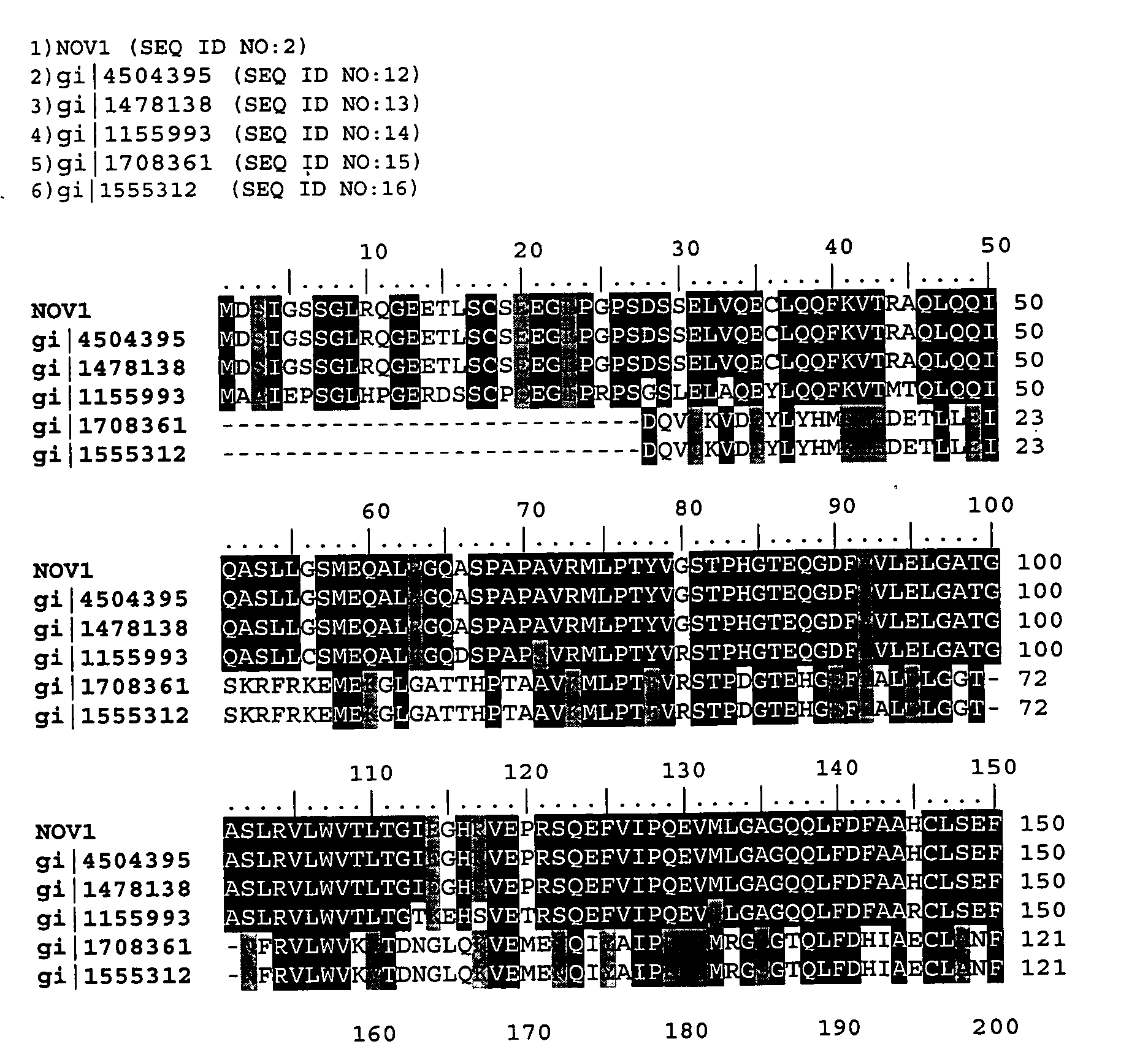Nucleic acids, polypeptides, single nucleotide polymorphisms and methods of use thereof
a technology of polypeptides and nucleic acids, applied in the field of nucleic acids, polypeptides, single nucleotide polymorphisms and methods, can solve the problems of defective or other variant protein expression, pathological condition, and amino acid sequence alteration, so as to increase serum bicarbonate levels, increase serum levels, and reduce systolic blood pressure
- Summary
- Abstract
- Description
- Claims
- Application Information
AI Technical Summary
Benefits of technology
Problems solved by technology
Method used
Image
Examples
example 1
NOV1 Sequence Analysis
[0388]
TABLE 3NOV1 Sequence AnalysisSEQ ID NO: 13205 bpNOV1,GACAAGAGCTCAGACCTGAGGAGAGTGACTAGCTTCTCTGTGTCCCAGGTGGCCACCG105201-01 DNA SequenceCTTCCACTGTGGAAGCTCATGGACTCCATTGGGTCTTCAGGGTTGCGGCAGGGGGAAGAAACCCTGAGTTGCTCTGAGGAGGGCTTGCCCGGGCCCTCAGACAGCTCAGAGCTGGTGCAGGAGTGCCTGCAGCAGTTCAAGGTGACAAGGGCACAGCTACAGCAGATCCAAGCCAGCCTCTTGGGTTCCATGGAGCAGGCGCTGAGGGGACAGGCCAGCCCTGCCCCTGCGGTCCGGATGCTGCCTACATACGTGGGGTCCACCCCACATGGCACTGAGCAAGGAGACTTCGTGGTGCTGGAGCTGGGGGCCACAGGGGCCTCACTGCGTGTTTTGTGGGTGACTCTAACTGGCATTGAGGGGCATAGGGTGGAGCCCAGAAGCCAGGAGTTTGTGATCCCCCAAGAGGTGATGCTGGGTGCTGGCCAGCAGCTCTTTGACTTTGCTGCCCACTGCCTGTCTGAGTTCCTGGATGCGCAGCCTGTGAACAAACAGGGTCTGCAGCTTGGCTTCAGCTTCTCTTTCCCTTGTCACCAGACGGGCTTGGACAGGAGCACCCTCATTTCCTGGACCAAAGGTTTTAGGTGCAGTGGTGTGGAAGGCCAGGATGTGGTCCAGCTGCTGAGAGATGCCATTCGGAGGCAGGGGGCCTACAACATCGACGTGGTTGCTGTGGTGAACGACACAGTGGGCACCATGATGGGCTGTGAGCCGGGGGTCAGGCCGTGTGAGGTTGGGCTAGTTGTAGACACGGGCACCAACGCGTGTTACATGGAGGAGGCACGGCATGTGGCAGTGCTGGACGAAGACCGGGGCCGCGTCTGCGTCAGCGTCG...
example 2
[0396]
TABLE 5SNP1 Sequence AnalysisSEQ ID NO: 33205 bpHexokinase 3-like DNAGACAAGAGCTCAGACCTGAGGAGAGTGACTAGCTTCTCTGTGTCCCAGGTGGCCACCTTCCACTGTGGAAGCTCATGGACTCCATTGGGTCTTCAGGGTTGCGGCAGGGGGAAGAAACCCTGAGTTGCTCTGAGGAGGGCTTGCCCGGGCCCTCAGACAGCTCAGAGCTGGTGCAGGAGTGCCTGCAGCAGTTCAAGGTGACAAGGGCACAGCTACAGCAGATCCAAGCCAGCCTCTTGGGTTCCATGGAGCAGGCGCTGAGGGGACAGGCCAGCCCTGCCCCTGCGGTCCGGATGCTGCCTACATACGTGGGGTCCACCCCACATGGCACTGAGCAAGGAGACTTCGTGGTGCTGGAGCTGGGGGCCACAGGGGCCTCACTGCGTGTTTTGTGGGTGACTCTAACTGGCATTGAGGGGCATAGGGTGGAGCCCAGAAGCCAGGAGTTTGTGATCCCCCAAGAGGTGATGCTGGGTGCTGGCCAGCAGCTCTTTGACTTTGCTGCCCACTGCCTGTCTGAGTTCCTGGATGCGCAGCCTGTGAACAAACAGGGTCTGCAGCTTGGCTTCAGCTTCTCTTTCCCTTGTCACCAGACGGGCTTGGACAGGAGCACCCTCATTTCCTGGACCAAAGGTTTTAGGTGCAGTGGTGTGGAAGGCCAGGATGTGGTCCAGCTGCTGAGAGATGCCATTCGGAGGCAGGGGGCCTACAACATCGACGTGGTTGCTGTGGTGAACGACACAGTGGGCACCATGATGGGCTGTGAGCCGGGGGTCAGGCCGTGTGAGGTTGGGCTAGTTGTAGACACGGGCACCAACGCGTGTTACATGGAGGAGGCACGGCATGTGGCAGTGCTGGACGAAGACCGGGGCCGCGTCTGCGTCAGCGTCGAGTGGGGCT...
example 3
Method of SNP Identification
[0399] SeqCallingTM Technology: cDNA was derived from various human samples representing multiple tissue types, normal and diseased states, physiological states, and developmental states from different donors. Samples were obtained as whole tissue, cell lines, primary cells or tissue cultured primary cells and cell lines. Cells and cell lines may have been treated with biological or chemical agents that regulate gene expression for example, growth factors, chemokines, steroids. The cDNA thus derived was then sequenced using CuraGen's proprietary SeqCalling technology. Sequence traces were evaluated manually and edited for corrections if appropriate. cDNA sequences from all samples were assembled with themselves and with public ESTs using bioinformatics programs to generate CuraGen's human SeqCalling database of SeqCalling assemblies. Each assembly contains one or more overlapping cDNA sequences derived from one or more human samples. Fragments and ESTs w...
PUM
 Login to View More
Login to View More Abstract
Description
Claims
Application Information
 Login to View More
Login to View More - R&D
- Intellectual Property
- Life Sciences
- Materials
- Tech Scout
- Unparalleled Data Quality
- Higher Quality Content
- 60% Fewer Hallucinations
Browse by: Latest US Patents, China's latest patents, Technical Efficacy Thesaurus, Application Domain, Technology Topic, Popular Technical Reports.
© 2025 PatSnap. All rights reserved.Legal|Privacy policy|Modern Slavery Act Transparency Statement|Sitemap|About US| Contact US: help@patsnap.com


